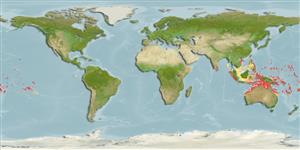>
Eupercaria/misc (Various families in series Eupercaria) >
Labridae (Wrasses) > Corinae
Etymology: Halichoeres: Greek, als, alis = salt + Greek, choiros = pig (Ref. 45335).
More on author: Randall.
Environment: milieu / climate zone / depth range / distribution range
Ecologia
marino associati a barriera corallina; distribuzione batimetrica 10 - 56 m (Ref. 90102), usually 33 - ? m (Ref. 1602). Tropical; 19°N - 25°S
Indo-Pacific: Cocos-Keeling Island and Rowley Shoals in the eastern Indian Ocean to the Marquesas and Pitcairn islands.
Size / Peso / Age
Maturity: Lm ? range ? - ? cm
Max length : 24.0 cm TL maschio/sesso non determinato; (Ref. 9710)
Spine dorsali (totale): 9; Raggi dorsali molli (totale): 12; Spine anali 3; Raggi anali molli: 12; Vertebre: 25. Fresh male specimens reddish brown dorsally, reddish ventrally; head with green bands; upper opercle with a large blue-edged black spot, rimmed with blue and red; 3 succession of spots behind eye. Large females may be similar in color with males but with a black spot on branched caudal rays; smaller ones have 3 black spots on dorsal fin base. Anterior lateral line scales with 2-7 pores, more in larger adults; 9-13 suborbital pores. Pelvic fins reaching or nearly reaching anus in large adults.
Common around patches of rubble or mixed rubble and coral along steep drop-offs (Ref. 1602) at 10-56 m depth (Ref. 90102). Feeds on benthic invertebrates (Ref. 89972).
Life cycle and mating behavior
Maturità | Riproduzione | Deposizione | Uova | Fecundity | Larve
Distinct pairing during breeding (Ref. 205).
Randall, J.E., G.R. Allen and R.C. Steene, 1990. Fishes of the Great Barrier Reef and Coral Sea. University of Hawaii Press, Honolulu, Hawaii. 506 p. (Ref. 2334)
IUCN Red List Status (Ref. 130435)
Threat to humans
Harmless
Human uses
Acquario: Commerciale
Informazioni ulteriori
BibliografiaAcquacolturaProfilo di acquacolturaVarietàGeneticaElectrophoresesEreditarietàMalattieElaborazioneNutrientsMass conversion
CollaboratoriImmaginiStamps, Coins Misc.SuoniCiguateraVelocitàModalità di nuotoArea branchialeOtolithsCervelliVista
Strumenti
Special reports
Download XML
Fonti Internet
Estimates based on models
Preferred temperature (Ref.
123201): 25.1 - 28.3, mean 26.8 °C (based on 10 cells).
Phylogenetic diversity index (Ref.
82804): PD
50 = 0.5000 [Uniqueness, from 0.5 = low to 2.0 = high].
Bayesian length-weight: a=0.00955 (0.00451 - 0.02020), b=3.09 (2.92 - 3.26), in cm total length, based on LWR estimates for this Genus-body shape (Ref.
93245).
Trophic level (Ref.
69278): 3.5 ±0.37 se; based on food items.
Resilienza (Ref.
120179): Medio, tempo minimo di raddoppiamento della popolazione 1.4 - 4.4 anni (Preliminary K or Fecundity.).
Fishing Vulnerability (Ref.
59153): Low vulnerability (14 of 100).
Nutrients (Ref.
124155): Calcium = 60.6 [37.2, 98.8] mg/100g; Iron = 0.627 [0.374, 1.125] mg/100g; Protein = 18.5 [15.7, 20.7] %; Omega3 = 0.155 [0.104, 0.230] g/100g; Selenium = 28.7 [18.1, 48.5] μg/100g; VitaminA = 121 [38, 433] μg/100g; Zinc = 1.46 [1.04, 2.25] mg/100g (wet weight);
